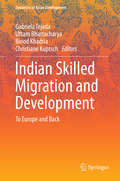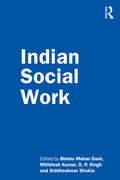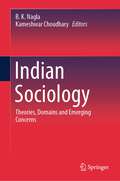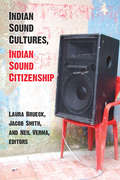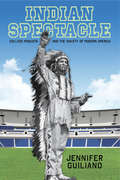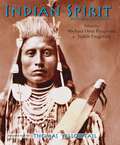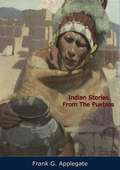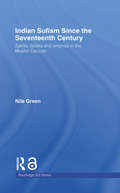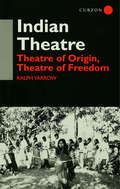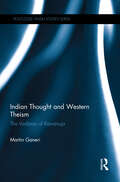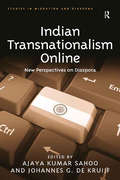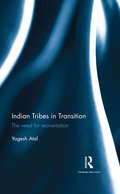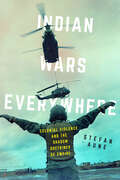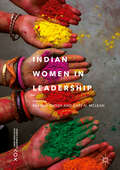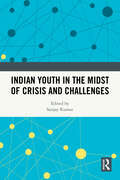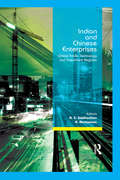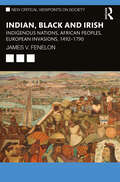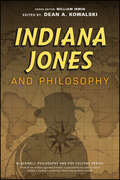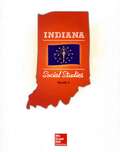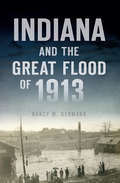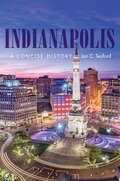- Table View
- List View
Indian Skilled Migration and Development
by Christiane Kuptsch Gabriela Tejada Uttam Bhattacharya Binod KhadriaThis edited contribution explores strategies and measures for leveraging the potential of skilled diasporas and for advancing knowledge-based evidence on return skilled migration and its impact on development. By taking the example of Indian skilled migration, this study identifies ways of involving returned skilled migrants in home country development as well as proposes approaches to engage the diaspora in development. As high-skill immigration from India to mainland Europe is a rather recent phenomenon, the activities of Indian professionals in Europe are under-researched. The findings have wider application in contributing to the policy dialogue on migration and development, specifically to the advantage for developing and emerging economies. The book employs an interdisciplinary, two-fold approach: The first part of the research looks at how international exposure affects the current situation of skilled returnees in India. The second, European, part of the research examines migration policies, labour market regulations and other institutional settings that enable or hinder skilled Indians' links with the country of origin. Structural differences between the host countries may facilitate different levels of learning opportunities; thus, this book identifies good practices to promote the involvement of Indian skilled diaspora in socio-economic development. In applying the framework of diaspora contributions as well as the return channel to study the impact on India, the book draws on qualitative and quantitative research methods consisting of policy analysis, in-depth interviews with key experts and skilled migrants and on data sets collected specifically for this study.
Indian Social Work
by Bishnu Mohan Dash; Mithilesh Kumar; D. P. Singh; Siddheshwar ShuklaThis book provides multiple frameworks and paradigms for social work education which integrates indigenous theories and cultural practices. It focuses on the need to diversify and reorient social work curriculum to include indigenous traditions of service, charity and volunteerism to help social work evolve as a profession in India. The volume analyzes the history of social work education in India and how the discipline has adapted and changed in the last 80 years. It emphasizes the need for the Indianization of social work curriculum so that it can be applied to the socio-cultural contours of a diverse Indian society. The book delineates strategies and methods derived from meditation, yoga, bhakti and ancient Buddhist and Hindu philosophy to prepare social work practitioners with the knowledge, and skills, that will support and enhance their ability to work in partnership with diverse communities and indigenous people. This book is essential reading for teachers, educators, field practitioners and students of social work, sociology, religious studies, ancient philosophy, law and social entrepreneurship. It will also interest policy makers and those associated with civil society organizations.
Indian Sociology: Theories, Domains and Emerging Concerns
by B. K. Nagla Kameshwar ChoudharyThis book presents a critical and reflective view of fundamental theoretical orientations, thematic domains, and current debates in Indian sociology. It covers the growth of sociology as an academic and pedagogical subject, with four main parts. Part I discusses important theoretical orientations in Indian sociology, including Indological and civilizational approaches, as well as the contributions of an eminent sociologist and pioneer in Indian sociology, Professor Yogendra Singh, concerning the sociology of knowledge, liberal democracy, and the relevance of his concept of Islamization in the study of Indian society. Part II examines substantive areas of study such as caste, class, and tribe. Part III reflects on specific topics of current concern in Indian sociology, such as emerging vistas and futures, globalization, and rethinking area studies for planetary conversations. This book is highly relevant for postgraduate students and researchers in sociology, social anthropology, and social sciences.
Indian Sound Cultures, Indian Sound Citizenship
by Jacob Smith Neil Verma Laura BrueckFrom the cinema to the recording studio to public festival grounds, the range and sonic richness of Indian cultures can be heard across the subcontinent. Sound articulates communal difference and embodies specific identities for multiple publics. This diversity of sounds has been and continues to be crucial to the ideological construction of a unifying postcolonial Indian nation-state. Indian Sound Cultures, Indian Sound Citizenship addresses the multifaceted roles sound plays in Indian cultures and media, and enacts a sonic turn in South Asian Studies by understanding sound in its own social and cultural contexts. “Scapes, Sites, and Circulations” considers the spatial and circulatory ways in which sound “happens” in and around Indian sound cultures, including diasporic cultures. “Voice” emphasizes voices that embody a variety of struggles and ambiguities, particularly around gender and performance. Finally, “Cinema Sound” make specific arguments about film sound in the Indian context, from the earliest days of talkie technology to contemporary Hindi films and experimental art installations. Integrating interdisciplinary scholarship at the nexus of sound studies and South Asian Studies by questions of nation/nationalism, postcolonialism, cinema, and popular culture in India, Indian Sound Cultures, Indian Sound Citizenship offers fresh and sophisticated approaches to the sonic world of the subcontinent.
Indian Spectacle
by Jennifer GuilianoAmid controversies surrounding the team mascot and brand of the Washington Redskins in the National Football League and the use of mascots by K-12 schools, Americans demonstrate an expanding sensitivity to the pejorative use of references to Native Americans by sports organizations at all levels. In Indian Spectacle, Jennifer Guiliano exposes the anxiety of American middle-class masculinity in relation to the growing commercialization of collegiate sports and the indiscriminate use of Indian identity as mascots. Indian Spectacle explores the ways in which white, middle-class Americans have consumed narratives of masculinity, race, and collegiate athletics through the lens of Indian-themed athletic identities, mascots, and music. Drawing on a cross-section of American institutions of higher education, Guiliano investigates the role of sports mascots in the big business of twentieth-century American college football in order to connect mascotry to expressions of community identity, individual belonging, stereotyped imagery, and cultural hegemony. Against a backdrop of the current level of the commercialization of collegiate sports--where the collective revenue of the fifteen highest grossing teams in Division I of the National Collegiate Athletic Association (NCAA) has well surpassed one billion dollars--Guiliano recounts the history of the creation and spread of mascots and university identities as something bound up in the spectacle of halftime performance, the growth of collegiate competition, the influence of mass media, and how athletes, coaches, band members, spectators, university alumni, faculty, and administrators, artists, writers, and members of local communities all have contributed to the dissemination of ideas of Indianness that is rarely rooted in native people's actual lives.
Indian Spirit, Revised and Enlarged
by Judith Fitzgerald Michael Oren FitzgeraldThrough its striking combination of stirring oratory and majestic portraiture from the Plains Indian pre-reservation &“old-timers,&” Indian Spirit reveals the very heart of the traditional Native American life-way: a world where dignity of soul, nobility of sentiments, discipline of gesture, and a sense of the Great Spirit in all things, reigned supreme. This heroic ideal of the Native American, blending the courage of the warrior with the wisdom of the priest, stands as a timeless exemplar for all peoples.
Indian Stories From The Pueblos: Tales Of New Mexico And Arizona (Beautiful Rio Grande Classics Ser.)
by Frank G. ApplegateIndian Stories from the Pueblos is a combination of tales of early Pueblo days and stories from 1929, when the book was first published. They were written by Frank Applegate, a New Mexican artist who lived among the Pueblos.Contains beautiful illustrations from original Pueblo Indian paintings and a foreword by Witter Bynner.
Indian Sufism since the Seventeenth Century: Saints, Books and Empires in the Muslim Deccan (Routledge Sufi Series #Vol. 18)
by Nile GreenSufism is often regarded as standing mystically aloof from its wider cultural settings. By turning this perspective on its head, Indian Sufism since the Seventeenth Century reveals the politics and poetry of Indian Sufism through the study of Islamic sainthood in the midst of a cosmopolitan Indian society comprising migrants, soldiers, litterateurs and princes. Placing the mystical traditions of Indian Islam within their cultural contexts, this interesting study focuses on the shrines of four Sufi saints in the neglected Deccan region and their changing roles under the rule of the Mughals, the Nizams of Haydarabad and, after 1948, the Indian nation. In particular Green studies the city of Awrangabad, examining the vibrant intellectual and cultural history of this city as part of the independent state of Haydarabad. He employs a combination of historical texts and anthropological fieldwork, which provide a fresh perspective on developments of devotional Islam in South Asia over the past three centuries, giving a fuller understanding of Sufism and Muslim saints in South Asia.
Indian Theatre: Theatre of Origin, Theatre of Freedom
by Ralph YarrowThis book sets out from the question: why have so many western theatre workers come to India and what were they looking for? What is it that seemed to be lacking in western performance and understanding of the nature and function of theatre? Locating Indian theatre as a major site of reappraisal and renewal both in India and in the world of perform
Indian Thought and Western Theism: The Vedānta of Rāmānuja (Routledge Hindu Studies Series)
by Martin GaneriThe encounter between the West and India in the modern period has also been an encounter between Western modernity and the traditions of classical Indian thought. This book is the study of one aspect this encounter, that between Western scholasticism and one classical Indian tradition of religious thought and practice: the Vedānta. In the modern period there have been many attempts to relate Western theistic traditions to classical Indian accounts of ultimate reality and the world. Parallels have usually been drawn with modern forms of Western philosophy or modern trends in theism. Modern Indological studies have continued to make substantial use of Western terms and concepts to describe and analyse Indian thought. A much-neglected area of study has been the relationship between Western scholastic theology and classical Indian thought. This book challenges existing parallels with modern philosophy of religion and forms of theism. It argues instead that there is an affinity between scholasticism and classical Indian traditions. It considers the thought of Rāmānuja (traditional dates 1017-1137 CE), who developed an influential theist and realist form of Vedānta, and considers how this relates to that of the most influential of Western scholastics, Thomas Aquinas (1224/5-1274 CE). Within what remain very different traditions we can see similar methods of enquiry, as well as common questions and concerns in their accounts of ultimate reality and of the world. Arguing that there is indeed an affinity between the Western scholastic tradition and that of classical Indian thought, and suggesting a reversal of the tendencies of earlier interpretations, this book will be of interest to students and scholars of Asian religion, Hinduism and Indian philosophy.
Indian Transnationalism Online: New Perspectives on Diaspora (Studies in Migration and Diaspora)
by Ajaya Kumar Sahoo Johannes G. KruijfPresent-day migration takes place in a world characterized by the compression of time and space, with cheaper air travel and the existence of new communication technologies - the internet in particular - making it easier to stay in contact with the places, people and cultures that one has left. This book investigates the online organization of, and exchanges within, the global Indian diaspora. Bringing together research from around the world and presenting studies drawn from the US, Europe and India, it engages with theoretical and methodological debates concerning the shaping and transformation of migrant culture in emerging sites of sociality, and explores issues such as religion, citizenship, nationalism, region and caste as they relate to Indian identity in global, transnational contexts. With detailed empirical case studies showing both how members of the Indian diaspora connect with one other and ’life at home’ and how institutions in India maintain such links, Indian Transnationalism Online sheds light on the ways in which information and communication technology functions as both a catalyst and indicator of contemporary socio-cultural change. As such it will be of interest to sociologists, anthropologists, political scientists and studies of cultural studies working in the areas of migration, transnationalism and ethnic studies.
Indian Tribes in Transition: The need for reorientation
by Yogesh AtalIndia has witnessed a sea change in its social structure and political culture since Independence. Despite the developmental model that the country opted for, the hangover of the Raj continued to encourage fissiparous tendencies dividing the Indian populace on the basis of religion, ethnicity and caste hierarchy. This book argues for the need to develop a fresh approach to dismantling the stereotypes that have boxed the study of India’s tribal communities. It underlines the significance of region-specific strategies in place of an overarching umbrella scheme for all Indian tribes. The author studies tribes in the context of changing political and social identity, gender, extremism, caste dimensions, development issues, and offers a new perspective on tribes to accommodate the diversity and transformations within culture over time and through globalization. Lucid, accessible and rooted in contemporary realities, this volume will be of great interest to scholars and researchers of sociology and social anthropology, tribal studies, subaltern and third world studies, and politics.
Indian Wars Everywhere: Colonial Violence and the Shadow Doctrines of Empire (American Crossroads #71)
by Stefan AuneReferences to the Indian Wars, those conflicts that accompanied US continental expansion, suffuse American military history. From Black Hawk helicopters to the exclamation "Geronimo" used by paratroopers jumping from airplanes, words and images referring to Indians have been indelibly linked with warfare. In Indian Wars Everywhere, Stefan Aune shows how these resonances signal a deeper history, one in which the Indian Wars function as a shadow doctrine that influences US military violence. The United States’ formative acts of colonial violence persist in the actions, imaginations, and stories that have facilitated the spread of American empire, from the "savage wars" of the nineteenth century to the counterinsurgencies of the Global War on Terror. Ranging across centuries and continents, Indian Wars Everywhere considers what it means for the conquest of Native peoples to be deemed a success that can be used as a blueprint for modern warfare.
Indian Women in Leadership (Current Perspectives on Asian Women in Leadership)
by Rajashi Ghosh Gary N. McLeanThis book provides intriguing insights into the development of highly qualified women leaders in diverse Indian contexts and their role at national and organizational levels. While India has made enormous economic strides in the past few decades, gender inequality and underutilization of female talent remain deeply rooted and widely spread in many parts of Indian society. This book addresses an urgent need to stop treating Indian women as under-developed human capital and begin realizing their potential as leaders of quality work. This book will fill the gap of research on international leadership for students, academics, and multinational organizations.
Indian Youth in the Midst of Crisis and Challenges
by Sanjay KumarOver one-third of the Indian population is made up of young people aged between 15 and 34 years. Such a large, young population is an asset to any nation, but today, young Indians are grappling with multifarious challenges hindering their growth. This book analyses factors that influence the youth’s decision-making processes, their navigation of societal norms, education choices, identity formation, and the evolving perceptions of tradition and modernity. It focuses on the changing patterns of marriage among the Indian youth, the challenges posed by the COVID-19 pandemic, and the ongoing changes in youth transitions and social reproduction in a modern society. The findings presented in the book provide crucial insights into how young Indians perceive their roles within their families, communities, and the broader society. The volume also offers valuable guidance on how to support and empower the next generation to build a resilient and prosperous future.Lucid, accessible, and empirically grounded, the book is indicative of the momentum and direction of change in the country. It will be useful to scholars and researchers of sociology, political sociology, political studies, youth psychology and anthropology. It will also be of interest to policymakers, journalists, and the interested general reader.
Indian and Chinese Enterprises: Global Trade, Technology and Investment Regimes
by N. S. SiddharthanFirst published in 2010. Routledge is an imprint of Taylor & Francis, an informa company.
Indian, Black and Irish: Indigenous Nations, African Peoples, European Invasions, 1492-1790
by James V. FenelonThis book traces 500 years of European-American colonization and racialized dominance, expanding our common assumptions about the ways racialization was used to build capitalism and the modern world-system. Professor Fenelon draws on personal experience and the agency of understudied Native (and African) resistance leaders, to weave a story too often hidden or distorted in the annals of the academy, that remains invisible at many universities and historical societies. The book identifies three epochs of racial constructions, colonialism, and capitalism that created the USA. Indigenous nations, the first to be racialized on a global scale, African peoples, enslaved and brought to the Americas, and European immigrants. It offers a sweeping analysis of the forces driving the invasion, occupation, and exploitation of Native America and the significance of labor in American history provided by Indigenous people, Africans, and immigrants, specifically the Irish. Indian, Black and Irish makes major contributions toward a deeper understanding of where Supremacy and Sovereignty originated from, and how our modern world has used these socio-political constructions, to build global hegemony that now threatens our very existence, through wars and climate change. It will be a vital resource to those studying history, colonialism, race and racism, labor history, and indigenous peoples.
Indian, Black and Irish: Indigenous Nations, African Peoples, European Invasions, 1492-1790 (New Critical Viewpoints on Society)
by James V. FenelonThis book traces 500 years of European-American colonization and racialized dominance, expanding our common assumptions about the ways racialization was used to build capitalism and the modern world-system.Professor Fenelon draws on personal experience and the agency of understudied Native (and African) resistance leaders, to weave a story too often hidden or distorted in the annals of the academy, that remains invisible at many universities and historical societies. The book identifies three epochs of racial constructions, colonialism, and capitalism that created the USA. Indigenous nations, the first to be racialized on a global scale, African peoples, enslaved and brought to the Americas, and European immigrants. It offers a sweeping analysis of the forces driving the invasion, occupation, and exploitation of Native America and the significance of labor in American history provided by Indigenous people, Africans, and immigrants, specifically the Irish.Indian, Black and Irish makes major contributions toward a deeper understanding of where Supremacy and Sovereignty originated from, and how our modern world has used these socio-political constructions, to build global hegemony that now threatens our very existence, through wars and climate change. It will be a vital resource to those studying history, colonialism, race and racism, labor history, and indigenous peoples.
Indiana Jones and Philosophy: Why Did it Have to be Socrates? (The Blackwell Philosophy and Pop Culture Series)
by William IrwinINDIANA JONES AND PHILOSOPHY What does it mean to choose wisely? Can heroes seek fortune and glory? Why does Indy take a leap of faith? Do Indy’s adventures provide him evidence of the supernatural? Should we hide the Ark of the Covenant in a military-controlled warehouse? Why are museums so important to archaeology? If adventure has a name, it must be Indiana Jones! He’s both a mild-mannered archaeology professor and an intrepid adventurer traversing the globe in search of lost artifacts. Whether seeking the Ark of the Covenant in Egypt, the Sankara Stones in India, the Holy Grail in Turkey, or a mysterious crystal skull in Peru, Indy’s adventures never fail to delight audiences. Indiana Jones and Philosophy takes you on a whirlwind journey to investigate some of the most enduring questions about the human condition. You’ll read about how Indy has wronged Marion Ravenwood, how a virtuous person would make amends, the strides Indy makes to repair his relationship with his father, why Indy distinguishes fact from truth when he pursues archaeological treasures, and much more. With trusty guides such as Aristotle, Camus, Kant, and Nietzsche at your side, you’ll consider possible answers to these questions and see Indiana Jones in a whole new light! Comprehensive, immersive, and engaging, Indiana Jones and Philosophy offers you an accessible and lively opportunity to dive deeper into the world of Indiana Jones and appreciate the character’s greatness anew!
Indiana Social Studies (Grade 4)
by Banks Linda Parker James A. Colleary Kevin P. Greenow Walter C.Indiana Social Studies (Grade 4)
Indiana The United States, Early Years [Grade 5]
by Dinah Zike James A. Banks Kevin P. Colleary Linda Greenow Walter C. Parker Emily M. SchellNIMAC-sourced textbook
Indiana Timelinks: People, Places and Culture in Europe and the Americas [Grade 6]
by Dinah Zike James A. Banks Kevin P. Colleary Linda Greenow Walter C. Parker Emily M. SchellNIMAC-sourced textbook
Indiana and the Great Flood of 1913 (Disaster)
by Nancy M. GermanoIndiana suffered enormous losses in the Great Flood of 1913, yet this disaster is largely forgotten. The combined tornado and flood barreled through Terre Haute, killing more than twenty. In Peru, 114 miles away, the circus lost most of its animals in the storm. At the southwestern corner of the state, a "sea of water," as local papers put it, washed over Evansville, turning streets into canals. In the capital, levee failures left hundreds homeless and vulnerable to disease and famine. Pulling from archival photographs, newspapers and local accounts, Dr. Nancy M. Germano shares stories from across the state to reveal how Indiana's history of settlement and development contributed to one of the state's worst disasters.
Indianapolis: A Concise History (Heartland History)
by Jon C. TeafordAs its name denotes, Indianapolis is without question Indiana's city. Known as the Crossroads of America, Indianapolis and the surrounding communities have and continue to play an important role in politics, logistics, and commerce for both the state and the country.Indianapolis: A Concise History looks at the development of the city from a frontier village to a major railroad city in the late nineteenth century and through its continued growth in the twentieth century. Author and historian Jon C. Teaford reveals the origins of the Indianapolis Speedway, the rise and fall of the Ku Klux Klan, the persistent racial tension in the city, and the revitalization efforts under Mayor William Hudnut and his successors. Since 1824 Indianapolis has been the state's largest city, its political center, and the home of Indiana's state government, and it continues to be a center for urban growth.
